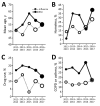Respiratory Syncytial Virus Infection in Homeless Populations, Washington, USA
- PMID: 31211675
- PMCID: PMC6590761
- DOI: 10.3201/eid2507.181261
Respiratory Syncytial Virus Infection in Homeless Populations, Washington, USA
Abstract
Homelessness has not previously been identified as a risk factor for respiratory syncytial virus (RSV) infection. We conducted an observational study at an urban safety-net hospital in Washington, USA, during 2012-2017. Hospitalized adults with RSV were more likely to be homeless, and several clinical outcome measures were worse with RSV than with influenza.
Keywords: COPD; RSV; United States; Washington; asthma; chronic obstructive pulmonary disease; drug use; homeless persons; homeless populations; homelessness; infection; influenza; influenza virus; respiratory infection; respiratory syncytial virus; viruses.
Figures


References
-
- Coleman V. Annual homeless count reveals more people sleeping outside than ever before. The Seattle Times. May 31, 2018. [cited 2018 May 31]. https://www.seattletimes.com/seattle-news/homeless/new-homeless-count-in...
Publication types
MeSH terms
Grants and funding
LinkOut - more resources
Full Text Sources
Medical

